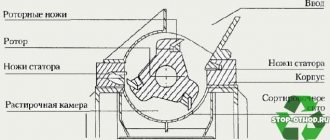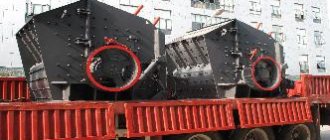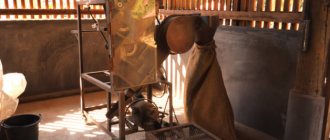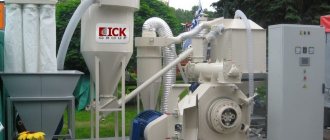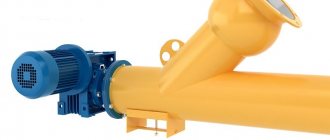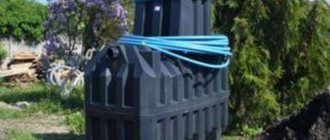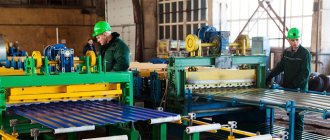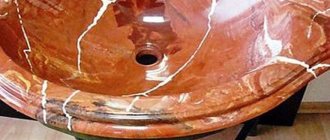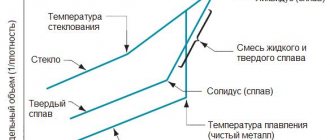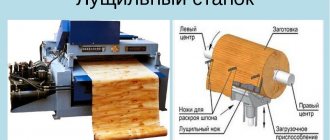Classification of roller crushers
Roller crushing systems are divided into types according to a variety of criteria and design features.
By the number of working bodies:
- single-roll machines are crushing units that have one single drive roll. Grinding occurs between the working body and the grate;
- two-roll - units with one movable roller to adjust the degree of grinding of the material, and one fixed working body.
- Three-roll and more crushing systems that allow you to achieve fine grinding of crushed materials or a medium degree of grinding of materials with increased hardness;
According to transport possibilities:
- mobile (mobile) – machines that can be transported as needed. Such units are widely used in construction, where very often the possibility of mobility of these devices arises;
- stationary – crushers that cannot be transported anywhere. Often such systems are installed in established technological processes and lines (metallurgy, slag processing, etc.).
According to the relief of the working bodies:
- crushing units with a smooth surface of working bodies;
- crushing systems with relief rolls;
- crushers with toothed work rolls.
Scope and types of hammer crushers - Click!
Hammer crusher is used in many industries.
The main work of a crusher is to crush and grind solid substances and materials in order to subsequently produce various solutions, mixtures and other substances from the resulting raw materials.
The hammer crusher is a fairly popular tool and occupies a decisive position in the entire production cycle.
Where is it used?
Crushing of materials is most often used in the agricultural sector. The grain hammer crusher is an important element in the production line of the highest quality feed products.
Grains of cereals and leguminous crops require special processing using specialized equipment. (By the way, read this article about the features of feed choppers).
The hammer crusher combines such important qualities as high speed of operation, reliability of the main components and assemblies, simplicity of design, safety in operation and compactness.
The product obtained after crushing is of high quality, which allows us to produce complete feed of the highest quality with the addition of high-tech fortifying additives.
The main internal structure of hammer crushers:
- hammer drum;
- loading funnel;
- hammers;
- decks;
- sieve.
Kinds
Closed Hammer Crusher
There are hammer crushers of open and closed types. The main characteristic of open type crushers is to crush only substances with a low degree of moisture, as well as fragile substances and materials.
Large pieces are crushed using hammer blows and the product is quickly removed from the crushing chamber. When moving inside the drum, it does not close a circle. This type of crusher most often crushes chalk, granules and shells.
In closed type crushers, the loaded material moves around the circumference of the crushing chamber several times. Next, the product becomes quite loose, and crushing hammers come into play. The final result is obtained from the combined impact action of crushing hammers and grinding of the substance during friction in the crushing chamber.
Basically, hammer crushers are used for materials that have a small or medium safety margin. The hammer crusher does not process sticky and viscous materials.
Principles of separation
Double Rotor Hammer Crusher
Number of working shafts:
- crushers with one working shaft;
- crushers with two working shafts.
Number of rotors:
- crushers with one working rotor;
- crushers with two working rotors.
Crushing hammer mounting type:
- crushers with freely moving hammers on hinges;
- crushers with rigidly fixed hammers.
Crusher shaft with free moving hammers
Hammer position:
- crushers with hammers arranged in one row;
- crushers with hammers arranged in several rows.
Rotor rotation:
- reversible crushers;
- wood crushers.
Flaws
For all its advantages, the use of hammer crushers in industry is overshadowed by its disadvantages:
Crusher Hammers
High wear rate of crushing hammers (crushing abrasives increases the likelihood of premature wear). Wear of grates when processing substances with a moisture content of more than 15 percent. If materials that are not completely crushed are accidentally loaded into the apparatus, damage to the main components and assemblies of the hammer crusher may occur. High price for the unit (from about 150,000 rubles).
To crush strong and hard materials, crushers with large, heavy hammers are used and, conversely, for crushing brittle materials, use light hammers.
The hammers themselves are made of high-tech steel, on the surface of which hard alloys are applied.
What pitfalls can you encounter when using a hammer crusher?
Very often, hammer crushers fail due to unbalanced movement of the rotors. Crushers are high-speed machines and their rotors need to be adjusted from time to time to prevent imbalance in their movement.
High dynamic loads on hammer crushers require timely and high-quality maintenance of these machines.
Watch the video in which a specialist explains the features of working on a household grain hammer crusher:
- DmitriiG
Advantages of jaw crushers
Jaw-type crushing units have the following advantages:
- simplicity of design;
- high wear resistance reduces the cost of operating and maintaining machines;
- easy installation and possibility of transportation due to the small dimensions of the units;
- The units maintain efficiency and stability of operation in all weather conditions;
- the accuracy and smoothness of adjustment of the slot width is ensured by the scale, and the hydraulic drive is responsible for adjusting the discharge opening;
- the enclosing shape of the fixed cheek contributes to a longer period of operation of the equipment;
- A continuous supply of oil is ensured by a centralized lubrication system.
The disadvantages include the fact that all jaw installations produce a product with an excess of flakier grains that are not subject to finer crushing, as well as the inability to use crushers for working with elastic and viscous materials: polymers, wood and some alloys.
Types of jaw crushers
The equipment differs in the method of installation on the chassis and the ability to move it into the following types:
Stationary crushers - provide for installation indoors, at production facilities, where it is important to work with large products. Mobile crushers - can be easily transported and work with small stones. Wheel crushers - the equipment is installed on a wheeled chassis and can be moved on a vehicle to a new work site. Track crushers are mounted on a tracked chassis, are heavy and can be transported within the construction site.
Classification according to the method of cheek attachment
According to the method of mounting the jaw, crushers are classified into lower and upper suspension types, which affects the operation of the equipment and the productivity of crushing. In particular, the first type refers to simple elements, the second to complex ones, which will therefore make it possible to regulate the choice of the most optimal system design, unit, in relation to specific types of work performed. The first version of the equipment is easy to maintain and repair, which therefore makes it the optimal solution for frequent use as construction equipment.
Features of classification by technological purpose
If it is necessary to carry out the construction of various objects, the disposal of large-sized material can be carried out using two types of crushing. In particular, this is large, or primary, the second is medium, secondary crushing, which is relevant when it is necessary to create a fraction of the desired type. This equipment has found wide application within production, in industry, where it can be used to obtain minor material. The equipment differs in design and has a complex mechanical chain.
Features of classification according to the kinematic scheme
Jaw crushers differ fundamentally in the existing kinematic diagram of the drive mechanism located as part of the structure of the unit. There are two types of design, the first of which is characterized by simple, the second complex movement. The simple design is distinguished by the ability to crush the material into large fractions, while the second one will allow for a similar operation, only dividing the stone into smaller components. It is worth noting that the simple design is much easier to maintain, which is facilitated by the design feature. Complex units will require the use of special tools and diagnostic equipment. Maintenance is carried out in a shorter time period established by the regulations.
Purpose of jaw crushers.
Jaw crushers are universal machines for crushing materials. It is used for crushing rocks of any strength, slag, as well as some metal materials.
Jaw crushers are used in all crushing areas: coarse, medium and fine. The input size of crushed material can reach 1500 mm. The finished product size for small jaw crushers can be 10 mm.
In technological processes of the mining industry, jaw crushers are used mainly for large (1500-350 mm) and medium (350-100 mm) crushing of ferrous and non-ferrous metal ores, coal, shale, non-metallic and other minerals.
The maximum degree of crushing of materials in jaw crushers reaches eight. But usually this figure is still less, for example, in cement production conditions, jaw crushers operate at crushing degrees from 3 to 6, at mining and processing plants and processing plants it is closer to 3. Material can be supplied to jaw crushers with natural moisture; normal operation occurs when the material moisture content is up to 6-8%. The actual performance of the jaw crusher and the crushed material depends on the properties of the feed material, its origin (geology) and the extraction method.
Jaw crushers are the most common type of technological equipment in processing plants. The specific energy consumption for crushing ranges from 0.3 to 1.1 kWh/t.
Due to the nature of the crushing process in a jaw crusher, the final product may contain from 25 to 50% of plates and flake grains. If the technological process includes high requirements for the shape of the resulting grains, then jaw crushers should be used only at the preliminary crushing stage. The final finishing of the finished product must be done on cone or rotary crushers.
The main advantages of jaw crushers are: simplicity of design, ease of replacement of wearing parts and spacer plates, ease of maintenance and repair, they are suitable for crushing viscous and clayey ores.
Disadvantages of jaw crushers: significant vibrations, requiring the crushers to be installed on a very solid foundation, which does not allow them to be installed on upper floors; require a uniform power supply, cannot work “under the blockage” and therefore require the installation of a feeder; not very suitable for crushing flagstone material; their replacement parts wear out faster than the replacement parts of cone crushers.
Jaw crushers are not used to destroy viscoelastic materials such as wood, polymers, and certain metal alloys.
Roll crusher device
a) operating principle; b) crusher device
1,2) rollers; 3) source material; 4) rigid support; 5) movable support; 6) spring; 7) frame
In machines of this type, the grinding of substances is carried out by a rotating roller. Crushing occurs between the driving working body and the grate type grate under the influence of compression loads. The surface of the working bodies (rolls) can be smooth, figured (corrugated) or serrated. The rollers are rotated by an electric motor, a gearbox and a cardan shaft, which increases the torque of the system, which allows for relatively significant crushing forces.
The most common are crushing systems with smooth working bodies, which are used for medium or fine crushing of solid fractions. Units with shaped or toothed rollers are used for coarse or medium grinding of brittle and soft materials.
The crushing system with smooth rolls has two parallel cylindrical mechanisms that rotate along horizontal axes. The drive roller mounted on the shaft rotates through special bearings that are capable of moving along the frame along the guides. The driven crown is mounted on a shaft, which rotates through bearings without such ability, but must absorb radial and axial loads. The fixation of the moving bearings is adjusted using rods, spacers, springs and tightening nuts. The springs can be pre-tightened, the modal value of which neutralizes the force generated during grinding. When non-crushed materials enter the unit, the drive roll adjusts the center distance of the rolls in such a way that it becomes possible to “pass” this element down. This function of roller crushers helps prevent unit failure. The working bodies are covered with a protective casing, which makes it impossible for dust generated during grinding of fractions to penetrate into the technological room.
Advantages and disadvantages of roller crushing systems
The advantages of roller units are:
- homogeneity of the output fraction shape;
- the simplest mechanical device;
- minimal problems during operation;
- efficiency of use;
- efficiency (low level of energy consumption, as well as wear resistance of unit components);
- convenience during repair work and maintenance;
- ease of adjusting settings;
- screening out the non-crushing (increased hardness) fraction);
- the receiving hopper can be unloaded without completely stopping the equipment first.
The disadvantages of roller grinding equipment are:
- sticking of parts of wet material onto the rollers;
- low productivity;
- low degree of crushing of materials;
- a high degree of wear on the working parts of the crusher, which results in greater labor intensity and downtime of mechanical equipment;
- possible distortions of the shaft on the mobile roll;
- impossibility of crushing materials with a hardness level of more than 160 MPa.
Advantages and disadvantages of drum type screens
The disadvantages of drum screens are:
- cumbersome design;
- small specific productivity;
- low efficiency.
The advantages of drum screening equipment are:
- simplicity of their mechanical design and maintenance;
- uniform operation of the system;
- Availability of emergency maintenance and cleaning of the work surface.
Advantages and disadvantages of a homemade device
A homemade garden shredder has many advantages:
- low cost compared to factory-produced equipment;
- the ability to create designs for specific purposes. For example, processed branches are often used as fuel, which requires special adjustment of the unit to produce larger-sized cuttings;
- in a homemade design, you can use parts that can easily be found in any garage or workshop;
- a homemade shredder can be used not only for crushing branches, but also for chopping grass, vegetables and fruits - as pet food or for recycling purposes;
- When making equipment yourself, you have the opportunity to use your mind and erudition, and apply your own skills and abilities. A successfully working structure will serve as proof of your worth as an owner, increase self-esteem, and raise authority among neighbors and acquaintances.
As for the shortcomings, there are practically none. The only thing I would like to note is that equipment of this type belongs to the category of dangerous, therefore, during the manufacture of the unit, structural elements should be provided to reduce risks, and during operation, adhere to the rules for handling such mechanisms.
Operating principle of jaw crusher
The rock is fed into the cavity, where it is exposed to two fairly massive plates. One of the jaw crusher plates automatically performs a translational-rotational movement, thus contributing to the destruction of the material. The plate that is located in a stationary position is called a fixed cheek, respectively, and the second is called a movable one.
The size of the supplied material is strictly limited by the hole located in the upper part of the structure. Directly when the two cheeks come together, the material is crushed, after which it flows out through the hole located in the lower part. The material is calibrated using the size of the bottom hole. After undergoing appropriate crushing, the material is fed to the central sorting line, where it is further divided according to fraction size. The final product can also be used in multi-fraction form, depending on the need for the technological process and the characteristics of production.
Working principle of jaw crusher
The operating principle of a jaw crusher is that solid materials are crushed by compressing two surfaces - the jaws. One cheek is motionless, it is securely fixed. The second surface is movable; it is set in motion using a special mechanism. If you look at the diagram of a jaw crusher, you can see that the surfaces are located at an angle to each other.
Jaw crusher operating diagram
Technical characteristics suggest the possibility of crushing even large lump materials. The movable cheek makes reciprocating movements. As a result, the angle between the crusher surfaces changes. When the cheeks are retracted to the maximum, large pieces of stone or concrete fall, and small pieces that have already been crushed fall even lower. Thus, during the working cycle in the jaw crusher, it is possible to achieve uniform grinding of solid materials.
Jaw crusher circuit
The design of most jaw crushers suggests the ability to adjust the distance between the working surfaces. Thanks to this, the installation can grind materials with different initial fractions and at the output get crumbs with pieces of different sizes.
Depending on the design of the jaw crusher, it can be used to crush the following fractions:
- large,
- average,
- small.
The linear dimensions of solid pieces for crushing can reach up to 1.5 m. At the same time, for small jaw crushers, the technical specifications provide for crushing to fractions of 1 cm in size.
One of the important characteristics of jaw crushers is the maximum degree of crushing. This technical indicator indicates how many times the crushed pieces will be smaller than the original ones. For a jaw crusher with maximum productivity, the degree of crushing can reach up to eight, although in practice for most installations this figure is from 3 to 6. It is less for machines designed for crushing rocks, but for crushers for concrete and cement it is close to six.
Considering the design and operating principle of jaw crushers, it is clear that the cheeks are subject to the most wear. They usually have a ribbed, corrugated surface, which provides the best crushing of stone, concrete, etc. By regularly updating spare parts for crushers and installing new jaws, you can achieve maximum productivity - and obtain crushed materials of predictable quality.
Rice. 1. Options for suspension and drive of the movable cheek: a - upper suspension and vertical connecting rod; b - upper floor weight on the eccentric shaft; c - upper suspension and horizontal connecting rod; g - lower suspension and vertical connecting rod; 0 — lower suspension and horizontal connecting rod; e - upper suspension of the double-sided cheek and vertical connecting rod; e - eccentricity.
The working elements of jaw crushers are two cheeks (Fig. 1): fixed 1 and swinging 2. The cheeks form a mouth. The material enters the mouth from above. When the cheeks come together, the pieces of material are destroyed, and when they diverge, the crushed material spills out through the lower gap of the mouth.
The movable cheek is suspended on an axis by the upper end as shown in Fig. 1, a, b, c and f, or for the lower one - fig. 1, d and d.
With an upper suspension, the greatest swing is made by the lower end of the movable cheek. The width of the slot changes during operation of the crusher. The granulometric composition of the crushed material emerging through this gap is different.
Rice. 1. Options for suspension and drive of the movable cheek: a - upper suspension and vertical connecting rod; b - upper floor weight on the eccentric shaft; c - upper suspension and horizontal connecting rod; g - lower suspension and vertical connecting rod; 0 — lower suspension and horizontal connecting rod; e - upper suspension of the double-sided cheek and vertical connecting rod; e - eccentricity.
The most widely used are jaw crushers with suspension options and movable jaw drives, shown in Fig. 1, a and b.
In Fig. Figure 2 shows a jaw crusher with an upper suspension and simple swinging of the movable jaw (see diagram in Fig. 1, a), the front wall of the jaw crusher has been removed.
Rice. 2. Jaw crusher with top suspension and simple swing of the jaw: 1 - frame; 2 — armor plates; 3 — spacer wedges; 4 - movable cheek; 5 — cheek swing axis; 6 - flywheel; 7 - eccentric shaft; 8 — connecting rod; 9 — lifting screw; 10 - movable wedge; 11 - persistent klii; 12 — pressure plates; 13 - thrust.
The lower part of the plate crushing zone is subject to the greatest wear. To increase service life, these slabs are made in such a way that as the lower part of the slab wears out, it can be turned upside down. The cross-section of the working planes of these plates is made with longitudinal protrusions of a triangular shape.
The process of destruction of the material occurs during the period of movement of the movable cheek in the direction of the fixed one. During the reverse stroke, the crushed material pours out through the lower slot.
Rice. 3. Pressure plates: a - weakened; b - with cut rivets; c - with weakened strips.
In Fig. Figure 4 shows a jaw crusher with an upper jaw suspension. Its upper end is mounted directly on the eccentric of the drive shaft, the lower one rests on the pressure plate 12 and is pulled towards it by a rod 10 through the spring 9. With this installation scheme for the cheek, its upper end moves in a circular motion, and the lower end moves along an arc of radius equal to the length of the pressure plate. The overall movement of the jaw is complex, so the crusher is called a complex jaw swing crusher.
Rice. 4. Jaw crusher with an upper suspension of the movable jaw on an eccentric shaft (section): 1 - frame; 2 — armor plates; 3 — spacer wedges; 4 - movable cheek; 5 - eccentric shaft; 6 - flywheel; 7 — lifting screw; 8 - movable wedge; 9 — tension spring; 10 - traction; 11—thrust wedge; 12 - pressure plate.
While the upper part of the cheek moves towards the stationary cheek and destroys large pieces of material, its lower part moves away from the stationary cheek, freeing the exit for the crushed material, and, conversely, when the upper part moves away from the stationary cheek and the crushed material falls down, the lower part approaches the stationary cheek and further destroys the material.
Attempts were made to create a jaw crusher without idle jaw movement (see Fig. 1, f), but such machines turned out to be bulky and did not become widespread in grinding technology.
In a jaw crusher with a complex jaw swing, there is no idle speed. When the upper part of the cheek moves away, the lower part works, and when the lower part moves away, the upper part works. This reduces uneven operation of the crusher and its drive. Since the movable cheek moves not only in the direction of the fixed cheek, but also along its own axis, a cutting action is added to the direct splitting action of the protrusions of the armor plates. This facilitates the process of destruction of the material, but increases the wear of the plates.
A significant disadvantage of these crushers is that the crushing forces are transmitted directly to the eccentric of the drive shaft. This makes it difficult to create large crushers and use them for coarse crushing.
P.M. Sidenko Grinding in the chemical industry (Chapter II. Shredders with splitting and breaking action)
Disadvantages of jaw crushers: significant vibrations, requiring the crushers to be installed on a very solid foundation, which does not allow them to be installed on upper floors; require a uniform power supply, cannot work “under the blockage” and therefore require the installation of a feeder; not very suitable for crushing flagstone material; their replacement parts wear out faster than the replacement parts of cone crushers.
Applications for roller crushing systems
In fact, roller crushing units can be found in everyday life anywhere. The same meat grinder can to some extent be considered a single-roll crushing plant. However, industrial units are much larger in size and, accordingly, in productivity.
Roller units have taken root well in the construction industry. Thanks to such installations, workers of such enterprises grind slag, construction waste and waste, gypsum, recycled bricks, etc.
Also, systems of this class are used in the chemical industry, in public utilities for primary crushing or pressing of waste, as well as in the food industry (crushing salt rock, etc.).
In the mining and metallurgical complex you can also find machines in this segment, however, due to some of their disadvantages, they are used less frequently compared to their analogues.
Design
Jaw crushers with a classic, simple movement have a jaw mounted directly on a fixed axle. The plates pivotally rest on the lower part of the connecting rod, with one of the plates resting on the cheek, the other on the adjusting device. One of the design elements is an eccentric shaft, through which the cheek receives rotation.
The design of the jaw crusher provides for the presence of two plates, one of which is securely fixed, while the second, on the contrary, is movable, therefore exposing the material to impact. In some modifications, both cheeks are made movable, which greatly simplifies stone processing and guarantees high quality crushing and material preparation. At the exit of the equipment there is a sorting line through which crushed stone is selected depending on the fraction.
The crusher, which has a complex movement, deserves special attention. In it, a movable type cheek is located directly on the drive shaft, its eccentric part. The movable cheek in the lower part is located close to the spacer plate. The other end of the slab will be structurally supported by an adjustment device located in the structure. There may be design differences and other modifications, depending on the installation method, technological purpose and a number of other factors.
Design of jaw crushers.
Now let's talk in more detail about the design features of jaw crushers. Despite the wide variety of specific design features, most modern jaw crushers are based on designs developed more than 100 years ago. In the USSR, jaw crushers were produced according to GOST 7084-85, in Russia according to GOST 27412-93.
The basic operating principle of a jaw crusher is quite simple. The crushing chamber is arranged in the shape of a wedge; it is formed by two crushing surfaces, also called “cheeks”. One of the jaws of the crusher is stationary, and the second jaw is mounted on a connecting rod, which ensures the movement of the upper edge of the jaw so that the latter makes a swinging movement.
The material to be crushed is fed into the crushing chamber from above. Due to the wedge-shaped shape of the crushing chamber, pieces of material are initially located along the height of the chamber, depending on their size from top to bottom.
The connecting rod shaft is driven into rotation through a V-belt drive from an electric motor or diesel engine. In the process of bringing the cheeks closer together, during compression, pieces of material are crushed; when the movable cheek moves away (idling), the crushed pieces move down under the influence of gravity. As soon as the size of the pieces reaches a given value (reduced to the size of the outlet), they leave the crushing chamber, and larger pieces are dropped in their place. Then the cycle repeats.
The design of the movable cheek allows for the horizontal position of the lower edge to be adjusted. In this way, the size of the outlet slot is fixed, which determines the maximum size of the crushed material at the exit from the jaw crusher. The side walls of the crushing chamber of the jaw crusher are not involved in the crushing process.
Quality materials must be used to manufacture crushers. Beds are most often made of steel grade 35L or St3. The most worn parts of crushers are the jaws; they are made of 35L steel. The working surface of the cheeks is lined with plates of high-manganese steel 110G13L. The plates have grooves, which makes it easier to crush pieces of ore. The eccentric shaft and the axis of the movable cheek are made of steel 40X, the tension spring is made of steel 60C2, the connecting rod is made of steel 25L, the wedge and slider of the adjusting device are made of steel 25GL. Crackers are also made of high-strength steel. Spacer plates and flywheels of crushers are cast from cast iron grades SCh-18-36 or SCh-24-34.
The design of the jaw crusher must ensure:
- 24-hour operation with stops for maintenance;
- protection of lubricated surfaces from dust;
- start from own drive;
- protection of parts (except for the safety part itself) from damage when non-crushable bodies enter the crushing chamber;
- no emission of crushed material during operation;
- safe access to fastening points for wearing parts, adjustment and lubrication;
- the possibility of attaching individual or standard shelters manufactured by the consumer to the frame for suction of dusty air in the area of loading and unloading materials;
- local and remote control of crusher mechanisms.
The nature of the movement of the movable jaw depends on the kinematic features of the jaw crusher mechanism. During the use of these crushers for processing various materials, a large number of very diverse kinematic schemes of the jaw crusher mechanism have been proposed.
All of them can be divided into two large groups:
- ShchDP is a jaw crusher with a simple movement of the jaw, the trajectories of movement of the points of the movable jaw of which are straight lines or parts of a circular arc. The main method of destruction of pieces in SHDP is crushing.
- ShchDS is a jaw crusher with a complex movement of the jaw; the trajectory of the points of the movable jaw are closed curves, most often ellipses. The main method of destruction of pieces in the ShchDS is crushing and abrasion. ShchDS-I is a jaw crusher with a ratio of the length of the receiving opening to its width of more than 1.6.
- ShchDS-II is a jaw crusher with a complex jaw movement and a ratio of the length of the receiving opening to its width of up to 1.6.
Each of the two main types of jaw crushers has its own advantages and disadvantages.
